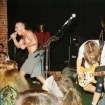For many fans, 2009 was either the year you started hating metalcore or the year you began loving it. Throughout the decade prior, the genre changed drastically from its early-Nineties origins as a mostly straightforward and largely uncommercial blend of heavy-metal heaviness and hardcore urgency. New Wave of American Heavy Metal bands like Killswitch Engage, All That Remains and As I Lay Dying injected stadium-sized melodies and mainstream metal fidelity into the sound that had already been handed off from Merauder and Earth Crisis to Eighteen Visions and Poison the Well.
Without discounting the importance of all the chaotic groups on the Dillinger Escape Plan and Every Time I Die side of the room, by the latter half of the 2000s, the term "metalcore" had much different connotations than it did in the Nineties — and in 2009, the genre took its most dramatic left-turn yet. In the wake of Attack Attack!'s meme-blasted yet highly influential 2008 song "Stick Stickly" — a neon melange of trance beats, auto-tuned pop hooks and bludgeoning breakdowns — metalcore had become a sandbox for bands to shape and mold however they pleased.
Within a few years, many of the groups on this list would skyrocket to headlining large venues worldwide and cracking the top 10 of the Billboard 200, but 2009 was ground zero, the moment that metalcore splintered in myriad new directions, and the seeds were sewn for the next decade's worth of sounds. From ahead-of-the-curve embraces of nu-metal and impeccably sleek production, to first-wave deathcore influence and pop-punk choruses, these are 10 essential albums from one of the most pivotal years in metalcore history.
A Day to Remember - Homesick
A Day to Remember aren't even a full-on metalcore band, and that's precisely what makes them the most significant act on this list in terms of their impact on the genre. The Florida gang emerged in the mid-2000s with a sound that seems obvious now but was surprisingly novel at the time: an even split between the chuggy breakdowns and screamed verses of metalcore, and the bouncy riffs and sing-along choruses of pop-punk. Many OG fans prefer their 2007 opus, For Those Who Have Heart, but 2009's Homesick was the breakout that launched them into the Warped Tour stratosphere and had an unquantifiable influence on a whole generation of bands who aped their balance of hooky and heavy.
Architects - Hollow Crown
Architects were way ahead of their time. Once 2009 rolled around, the U.K. crew had warmed up to their fiery new frontman, Sam Carter, and the whole band sounded young and hungry on their third LP, Hollow Crown. U.K. metalcore has always had a slightly different vibe than the North American variant, and on this album, Architects set the template for the cold, dreary and caustic style that Bring Me the Horizon would go on to emulate on their 2010 smash, There Is a Hell, Believe Me I've Seen It... Compared to the robotically tight playstyle, glowing choruses and squeaky-clean production that would dominate the U.S. front at the turn of the decade, Hollow Crown is heavier, groovier and more ragged, though just as big and bold sounding. Out of all the records on this list, it's the one that sounds the most current in 2021, which is quite an impressive feat.
Asking Alexandria - Stand Up and Scream
Unlike Architects, Asking Alexandria were a group of Englishmen with an unabashed affinity for American metalcore. As students of the Attack Attack! playbook, the band — fronted by the bombastic Danny Worsnop — traveled to Connersville, Indiana, to record their 2009 debut with AA!'s producer Joey Sturgis, whose signature touch would become the gold standard in the following years. Stand Up and Scream was a pointed rebuke of the athletic guitarwork and scraggly mosh parts of the previous generation — a breakdown-addled, electro-infused, lyrically vapid take on metalcore that was loathed by old-heads as it became the new face of the genre. The next half-decade gave way to a whole cottage industry of bands who based their careers around regurgitating the structure of "The Final Episode (Let's Change the Channel)."
August Burns Red - Constellations
Not all metalcore bands swerved in radically new directions. Along with Parkway Drive in Australia and While She Sleeps in the U.K., August Burns Red carried the torch for NWOAHM-style metalcore throughout the 2010s, and their 2009 opus, Constellations, was their first masterwork. Technical but unpretentious, anthemic yet scorching, and as symphonically epic as it is moshable, that record boasts standards like "White Washed" and "Marianas Trench" which found a loving home among fans who loved Darkest Hour riffs as much as they did Bury Your Dead breakdowns. However, the element that distinguished Constellations from the records that inspired it was the impressive amount of beauty and atmosphere that ABR conjured, from the tuneful lead licks and ferocious yet sing-able vocal deliveries.
Blessthefall - Witness
Another subset of metalcore that diverged in 2009 was the eyelined and white-belted iteration that was popularized in the mid-2000s by bands like Alesana, Drop Dead, Gorgeous and From First to Last. As influenced by yelpy mall screamo as they were pierced-lip metalcore, the bands who emerged from that school of thought generally went one of two ways in the 2010s — poppier (see: Pierce the Veil, Sleeping With Sirens) or heavier. Blessthefall fell into the latter category on their 2009 sophomore album, Witness, which saw new frontman Beau Bokan lean his nasally, swoopy-haired croons against bassist Jared Warth's chest-puffing screams for dramatic effect. Blessthefall didn't redefine the genre on this album, but they tightened its bolts and rounded its edges in a way that felt distinctly modern at the time.
The Devil Wears Prada - With Roots Above and Branches Below
The Devil Wears Prada's first two albums, 2006's Dear Love: A Beautiful Discord and 2007's Plagues, were incredibly impactful to metalcore's new era on a songwriting level, but the presentation of With Roots Above and Branches Below is what makes it one of the 21st century's most seminal releases. Recorded by the aforementioned Joey Sturgis, the production on this record sounded absolutely exquisite by 2009 standards. Its punctuated crispness allowed plenty of space for the band's rich keyboard textures, the rubbery low-end made their bouncy breakdowns pop out of the speakers and the well-balanced mix didn't let Mike Hranica's animalistic screams or Jeremy DePoyster's soaring cleans get buried amid the ruckus. At the time, nothing else sounded quite like it — and then everything did.
Emmure - Felony
Although many people would reasonably consider Emmure a deathcore band, their simple yet singular breed of seething chuggery opts for all of the 'core and almost none of the death metal, which makes metalcore feel like a better home for these sonic drifters. The controversial band's 2009 breakout, Felony, sounds as hair-raisingly pissed today as it did when it came out, and it's also now more apparent than ever how cutting-edge Frankie Palmeri's embrace of nu-metal swagger was in 2009, nearly a full decade before countless metalcore bands started adding rapped verses and hip-hop grooves into their sound. Besides the straight-up clones, there really aren't any other bands who've replicated the numb, hypnotic sensation that Felony's onslaught of constant breakdowns provides. Love it or hate it, its uniqueness is undeniable.
I See Stars - 3D
I See Stars' 2009 debut, 3D, isn't a metalcore album per se, but its candied dance beats, auto-tuned cleans and squirelly energy had more of an impact on metalcore in the years to come than any of its sibling genres. The electronicore pioneers were doing this sort of thing about a year before Attack Attack! got Myspace famous from it, and when they synthesized (no pun intended) all of the elements into this absolute nutjob of an album, it sounded like absolutely nothing else at the time. Within a year, 3D's influence was felt on everyone from Abandon All Ships and Eskimo Callboy to Woe, Is Me and the Word Alive, and even I See Stars themselves would embrace a more robust metalcore sound just a few years later.
Miss May I - Apologies Are for the Weak
On later records, Miss May I would begin emulating the conventional NWOAHM sounds that they grew up listening to, but their 2009 debut sounded fresh and innovative by the standards of the day. Unlike some of the other albums on this list, the production quality of Apologies Are for the Weak was never its strong suit, but the Ohio band's fusion of Unearth-style riffage, throat-searing shrieks and crushing, double-bass-reliant breakdowns made it such an album of its time. By 2012 or so, Apologies' specific alignment of first-wave deathcore maneuvers and second-wave metalcore choruses already sounded dated, but if you were on the right Myspace pages and Blogspot profiles in 2009, then "Architect" and "A Dance With Aera Cura" were inescapable.
We Came as Romans - To Plant a Seed
The title of We Came as Romans' 2009 debut, To Plant a Seed, is almost too on the nose. The Michigan band's first LP yielded an entire forest's worth of bands who were drawn to their forward-thinking veneer of prettiness that was painted on otherwise sturdy metalcore — a sound that should largely be credited to the man of the year, producer Joey Sturgis. The band's guitar tones are bright and sparkling, the leads are spiraling and decorative like Christmas ornaments, and the halo-like effects on late vocalist Kyle Pavone's svelte clean vocals give their music an ethereal and otherworldly sensibility. There are plenty of breakdowns to go around on To Plant a Seed, but it's everything around the meat-and-potatoes chugs that made the album such a marvel in 2009.












